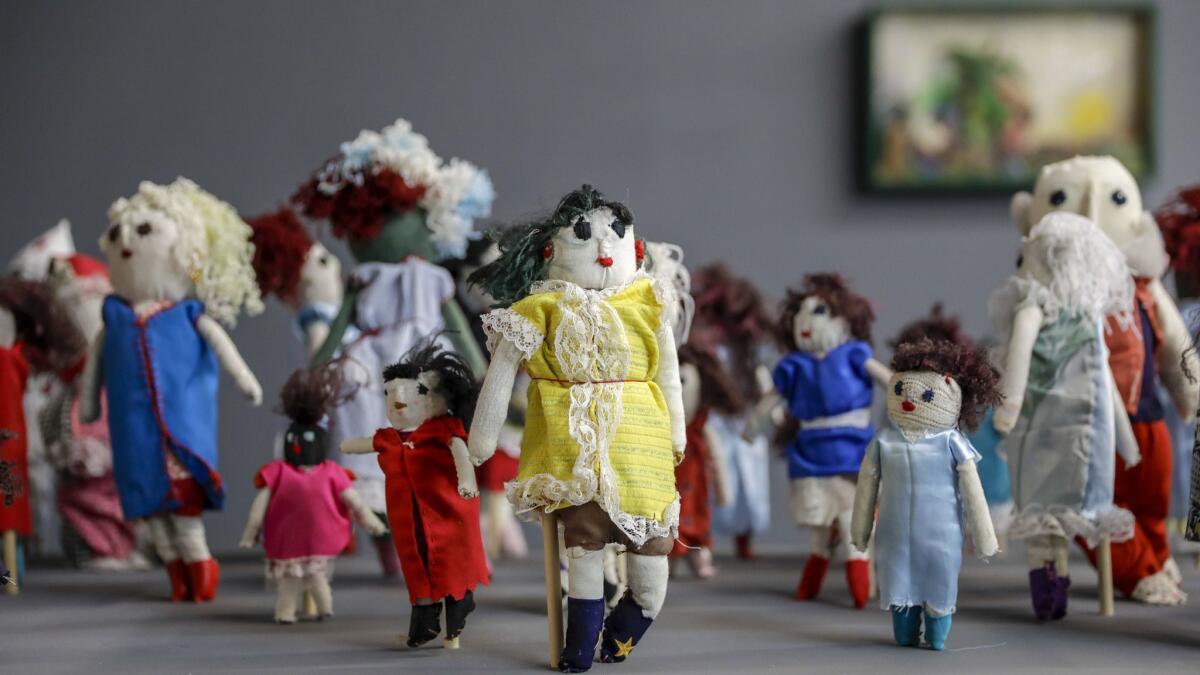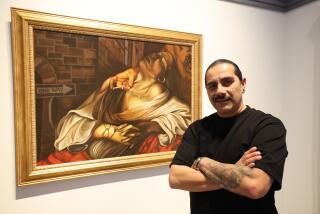For one family of artists, the separation of children from parents stirs haunting memories

Toward the back of the L.A. art gallery called the Mistake Room hangs a painting of a preteen girl with one hand on her hip and the other pointed defiantly at a military general.
The artist, Juan Edgar Aparicio, titled it “Pesadilla de un General” (Nightmare of a General) and dedicated the painting to children who were kidnapped or killed during the 1980s war between the military-led Salvadoran government backed by the U.S. and the guerrilla group Farabundo Marti National Liberation Front, better known by the Spanish acronym FMLN.
“It’s a reminder for the military soldiers and tyrants that there are children who died by their hand, like my first daughter,” Aparicio said by phone from his home in El Salvador. “The girl embodies the nightmare that won’t let them live or sleep in peace for what they have done.”
The painting is a focal point of “My Veins Do Not End in Me,” an exhibition that explores not only the Salvadoran immigrant community in L.A. but also the legacy of the Salvadoran civil war through the work from three generations of a single family: Aparicio; his mother, the late Maria de la Paz Torres de Aparicio; and his son, Eddie Rodolfo Aparicio. It’s a show that resonates all the more potently following this country’s recent immigration crisis, as families fleeing violence in Central America were detained at the U.S. border and children were separated from their parents.
Eddie Aparicio spent months looking for pieces of his father’s art for the Mistake Room show.
“I took on finding the works because it was an opportunity to re-engage with all these histories, the stories and the memories that I was too young to absorb,” he said. “Thinking about what the works meant versus who bought them and where they are now is interesting.”
Step inside the gallery and you have a view of all three artists’ work. To your left and right, Eddie’s grandmother’s handmade dolls stand on tables. At the center, Eddie’s immense casts of trees are arranged in a way that frame “Pesadilla de un General.”
Eddie’s father was a student leader and organizer who responded to socioeconomic disparities and human rights violations in El Salvador, but he ultimately left the country after his daughter, wife and brother disappeared — taken by government forces during a war that lasted from 1980 to 1992.
Juan continued his activism through community and arts organizations in L.A. and still sees art as an instrument for protest, whether the issue is gay rights or social injustice in El Salvador. (He moved back to El Salvador when Eddie, his youngest son, grew older.)
For Eddie, the parallels between past and present have been striking.
“My first response was this is the most recent version of children in El Salvador being separated from their families,” Eddie said. “As catalyzing as this event has been, I can think of so many events in Salvador where children have been separated unwillingly, whether it’s conscripted into the military or [by] left-wing guerrillas, or conscription of gangs that forces so many minors to come to the U.S.”
The girl embodies the nightmare that won’t let them live or sleep in peace for what they have done.
— Juan Edgar Aparicio, who painted “Pesadilla de un General” after his wife, daughter and brother disappeared during the Salvadoran civil war
Eddie and co-curators Cesar Garcia and Nico Orozco-Valdivia discussed a solo exhibition, but when Garcia saw the grandmother’s dolls and the father’s wood-carved piece, “Los Milicianos Bajo Fuego” (The Militiamen Under Fire) in a corner of Eddie’s studio, the direction changed.
“After the election, I questioned the use of subtlety,” Eddie said, adding later: “There is more urgency now, which is why I was so quick to jump into having the show with my father and grandma. It takes the work out of subtlety and makes a point.”
Eddie’s loudest piece is “Holbein en Crenshaw.” He grew up near Pico and Crenshaw boulevards, so he takes the imprints of trees there or in places with large Central American communities like in Boyle Heights, City Terrace, Highland Park and Pico-Union. He renders the bark, with its natural and human-made marks, with rubber and wood glue. In one piece, a yellow mark across the middle reveals itself from one angle to be a skull, a reference to German painter Hans Holbein the Younger’s 1533 piece “The Ambassadors,” in which a black and white smudge near the bottom of the scene looks like a skull.
The bark is backed with fabric that Eddie finds on the street near his tree subjects or gets from his family members. The piece is draped with a comforter and black hoodie. On top, he drew logos for the Pollo Campero restaurants and Folgers coffee with house paint — more items carried across the border. You can see a faded FMLN logo, representing the party both of his parents supported, and a poem that he wrote, inspired by Nicaraguan priest and poet Ernesto Cardenal, about a person killed and buried in an unmarked grave.
At a recent talk at the gallery, artist Beatriz Cortez told the full audience that the show is a “conversation between generations of memories, heritage, material and practice — how we make work. It’s about a family inheriting not only memory of the war, but memories of making and creating.”

Eddie’s late grandmother is remembered not only through her own work but also in Juan’s portraits, in which he captures the personalities and imagined lives of her handmade dolls. She’s also seen more directly in the wood-carved piece “La Familia Salvadoreña,” (The Salvadoran Family), in which she’s depicted holding a photo of her disappeared son.
In the gallery conversation, Eddie recounted a moment from his MFA program at Yale. In a class critique, a professor told him that his work felt overburdened — that as an artist, these heavy topics weren’t leaving space to make other things. Eddie couldn’t remember if he responded to the professor’s critique, but he wondered if the professor would have said the same thing to a white student or an African American student.
“It helped me understand my appreciation for these histories,” he said. “I have a specific way of knowing through my family and their experiences that is worth thinking about, worth not ignoring.”
♦ ♦ ♦ ♦ ♦ ♦ ♦ ♦ ♦ ♦
‘My Veins Do Not End in Me’
Where: The Mistake Room, 1811 E. 20th St., Los Angeles
When: 11 a.m.-6 p.m. Wednesday-Saturday
Information: (213) 749-1200, www.tmr.la
See all of our latest arts news and reviews at latimes.com/arts.
More to Read
The biggest entertainment stories
Get our big stories about Hollywood, film, television, music, arts, culture and more right in your inbox as soon as they publish.
You may occasionally receive promotional content from the Los Angeles Times.







